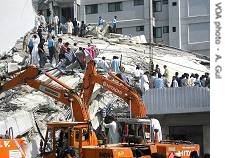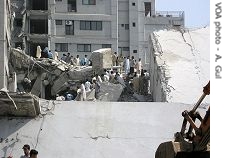Earthquakes : What can be done to reduce the effects ?
(This article was based on an earthquake in 2005)
Another major earthquake in 2005 killed over 19,000 of people in Pakistan, and over 42,000 have been estimated to be injured.
Information about the most recent earthquakes can be found at https://www.worlddata.info/earthquakes.php
What can be done to reduce the effects of earthquakes?


(Image source: Voice of America www.voanews.com (Public Domain Images))
The awful truth is that we simply cannot prevent earthquakes from happening.
The latest locations of earthquakes are illustrated athttp://www.iris.edu/seismon/ . However, we can reduce the impact of earthquakes by a number of strategies.
We all live oÂn top of geological plates. These plates are being moved by the semi-liquid mantle. These enormous convection currents beneath the surface provide the tremendous forces that move the plates. Some plates move towards each other, and oÂn other places the plates are moving away from each other. If you live near the boundaries of the plates the movements can have devastating effects. The mechanism of earthquakes is illustrated at http://news.bbc.co.uk/1/hi/sci/tech/4126809.stm
Reducing the Effects of an Earthquake
There are a number of strategies that can be used to reduce the imact of earthquakes. They all involve being fully prepared for the impact.
1. Install adequate warning systems.
Warnings of the oÂnset of earthquakes can be detected by organisations and governments. This involves the use of special sensing equipment. However, this alone will not be of much use without effective communication systems in place. Warning systems should be linked to government agencies, rescue and emergency services, and of course to the public.
2. Have a unified plan of action
The recent hurricane disaster in the USA highlighted the problems that an arise by not having a co-ordinated plan of action that can be initiated immediately. Time is of the essence in the case of major disasters. Delay in support/action can result in further deaths. Local, national and international support services should know exactly what to do, and how they work together to produce a rapid, efficient and effective support system.
3. Provide information before the earthquake strikes
This can involve the use of radio, TV and newspapers.
Everyone should know
(i) What precautions they need to take for the own safety and for the safety of others.
(ii) How to secure their home and belongings against damage
(iii) What to do during an earthquake.
4. Provide rapid and efficient support services after an earthquake
Apart from medical assistance, people need food, water and accommodation. Moreover, they need these things fast! Delays in bringing rescue services to the affected areas of population can result in people dying when they have been trapped in buildings. Manual movement of large amounts of rubble can prove virtually impossible to achieve in a few hours, for large areas of destruction. Therefore, heavy duty machinery is needed to reduce the time taken for rescues to be achieved.
5. The future? Earthquake-Proof Buildings?
It is unlikely, given the tremendous forces that exist in an earthquake, that a building could ever be made earthquake-proof. However, there are a number of ways that existing buildings can be mode more resistant to earthquake damage. New buildings can be designed to have a number of structural features which are more likely to provide resistance to the damaging effects of earthquakes. Structural damage could still occur, but the safety of the people inside the buildings is greatly enhanced by these special features. Many of the injuries sustained by people are as a result of falling debris from buildings, including broken glass. Special attention to these potential hazards is an priority in the design of earthquake-resistant buildings.
The techniques involved in the design include:
(i) Base isolation
This works by essentially separating the building from the moving ground during an earthquake. The base will move with the ground, but the movement to the rest of the buiding is minimised by the provision of special features such as Teflon pads, enormous rollers, coiled springs
(ii) Diagonal bracing
Shearing forces as distinct to push and pull forces, can cause tremendous damage to buildings. Diagonal bracing helps to minimise the effect of these shearing forces during an earthquake.
(iii) Passive damping.
Passive damping involves using a range of techniques. The main objective is to absorb the energy without allowing it to impact oÂn the main structure of the building. Certain methods use materials which will deform easily, and therefore absorb the energy, without breaking. Other techniques include the use of large masses which are made to move out of phase with the movement caused by the earthquake. This tends to cancel out the disturbance, just like a trough of a wave in water meeting a crest of a wave will result in calm water (destructive interference in waves) ...
More information: Safer Structures
Build Smart, Not Hard
Earthquake-proof (Wikipedia article)
Further Information oÂn Planning/Preparation for Earthquakes
An excellent resource, aimed for the public and businesses in the San Francisco Bay Area, has been produced by the Association of Bay Area Governments .
The topics include
Preparing for Traffic
Tsunamis


